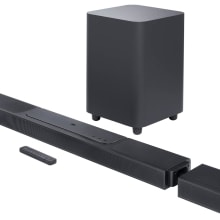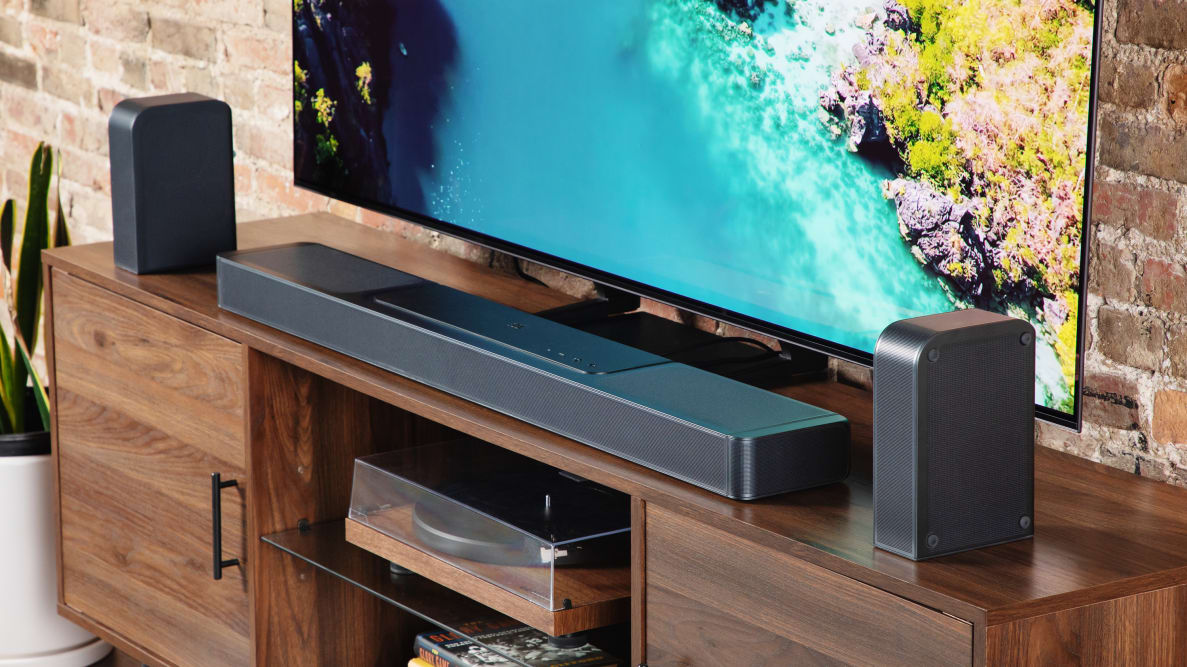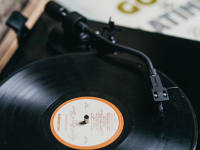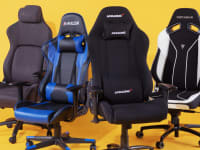Pros
-
Insanely deep and powerful bass
-
Plenty of HDMI inputs
-
Expansive, room-filling sound
Cons
-
Not great for stereo music
-
Configuration settings are limited
-
The remote is frustratingly enigmatic
Despite the more-more-more approach across the board, it’s really the subwoofer that sets the Bar 1300X most apart from its closest competitors. With its 12-inch down-firing driver, it’s capable of cranking out the sort of truly staggering bottom end necessary to deliver the visceral impact of today’s action-packed Atmos and DTS:X movie mixes.
As with the JBL Bar 1000 and Bar 700, though, the 1300X features wireless surround speakers that can also be docked on either end of the main soundbar for charging, if you’d prefer not to connect a USB-C cable for such purposes. Or you can use the surround speakers as standalone Bluetooth speakers either individually or in a pair.
That might be a selling point for some, but a few sonic quirks make the Bar 1300X much better suited to movie night than music listening. With music—whether in Atmos mode or with the satellite speakers docked and function as stereo left/right speakers—the bass is simply too uneven, and the Bar 1300X’s processing can make your favorite tunes sound more than a little off.
Spread the surround speakers out, though, crank up an action movie soundtrack, and you’ll soon forget about the system’s shortcomings.
About the JBL Bar 1300X

The JBL Bar 1300X includes a generous three HDMI inputs.
- Price: $1,699.95
- Height x Width x Depth: Soundbar: 60 x 1376 x 139 mm (2.4 x 54.2 x 5.5 in); Subwoofer: 481 x 366 x 366 mm (18.9 x 14.4 x 14.4 in)
- Weight: Soundbar: 4.3kg (9.5 lbs); Detachable surround speakers (each): 1.25 kg (2.75 lbs); Subwoofer: 15.65 kg (34.5 lbs)
- Wireless connection: 802.11 a/b/g/n/ac/ax Wi-Fi (2.4GHz/5GHz); Bluetooth 5.0 (main bar); 5.2 (detachable surround speakers)
- Wired connection: HDMI eARC in/out; 3x HDMI input; optical digital, USB Type A
- Sound formats: Dolby Atmos, DTS:X, MP3
- Video support: HDR10, Dolby Vision
- Warranty: 1 year
For such a complicated soundbar, setup of the Bar 1300X is surprisingly easy, assuming you have a hard-wired Ethernet connection at your disposal. Wi-Fi setup can be a little tricker, but no more so than products from Play-Fi or the like. The thing that most people will have to adjust to, we think, is that you won’t be plopping the surround speakers in one spot and leaving them there.
You might, if you want to charge them via USB-C (in our testing, they held a charge for two or three days depending on what and how much we watched), but it’s easy enough to dock them on the ends of the soundbar itself for a power top-off.
Calibrating the surround speakers for your room is a two-step process that involves positioning them right beside your main listening positioning and pressing a button that initiates a series of test tones, then moving them to where they’ll reside during movie watching and pressing the button again, at which point both the surround speakers and the soundbar emit test tones.
Unlike a lot of soundbar systems, the Bar 1300X also comes with all the hardware you’ll need to wall-mount the main bar and surround speakers alike. JBL also packs in a 1.2-meter HDMI cable, although if you need extra HDMI cables or an optical digital audio cable, you’re on your own there.
What we like
The subwoofer is a monster

The down-firing 12-inch woofer provides an impressive amount of bass.
The wireless subwoofer that comes with the Bar 1300X isn’t dainty, it won’t fit under the sofa, and it’s going to dominate any corner you put it in. But that’s the price you pay for the sort of bone-crunching bass this big box cranks out.
It’s the only soundbar system that springs immediately to mind that can truly do justice to the spaceship flyover at the beginning of Star Wars: Episode II, and it handily flexed its muscles with bass torture tests of the sort we normally reserve for legitimate standalone subwoofers—like the sewer fight in The Amazing Spider-Man.
Granted, the sub is tuned more for movies than music, which is something we’ll dive deeper into in a bit. But if what matters to you most when shopping for a subwoofer is bass that goes “BOOM,” there’s a lot to love about this one.
HDMI inputs galore
More often than not these days, soundbars only come with a single HDMI ARC/eARC connection, assuming you’ll be doing most of your viewing via the streaming services built into a smart TV or routing any additional sources through the TV’s inputs.
The Bar 1300X includes a generous three HDMI inputs, though, along with its HDMI eARC connection, so if you’d like to route your streaming media player, disc player, and/or cable/satellite box through the soundbar itself, that’s an easy option here. The JBL isn’t alone on that front, but it’s still noteworthy.
It never struggles to fill the room with sound
With a blockbuster mixed in Atmos, such as Avatar: The Way of Water (either via Disney+ or on UHD Blu-ray, the overhead sound effects aren’t quite as pronounced and discrete as we’ve heard with other Atmos-capable soundbars (even with the Dolby Atmos/DTS:X effect control turned to the highest of its three levels).
But they’re every bit as immersive and do a great job of integrating the sound of the main soundbar and surround speakers, giving you a more immersive listening experience all the way round.
Listening to too-aggressive Atmos sound mix—like the one accompanying Apollo 10½ on Netflix—the JBL tamed some of the distracting overkill of it all without diminishing in any way the immersiveness of the sound experience. Sound still spread from wall to wall and floor to ceiling, but there was just a bit more connective tissue between the front and rear soundstages and the overhead effects, weaving it all into a more cohesive listening experience.
That cohesion does fall apart a little if you’re not sitting between the left/right extremes of the main soundbar, so if you tend to watch movies with friends and family, you’ll all need to squeeze into a little less than 40 inches of couch real estate. Anyone sitting outside that bubble will experience a decidedly more lopsided experience, but that’s not out of the ordinary with soundbars—even ones this large.
What we don’t like
It isn’t great for music listening

The JBL Bar 1300X is much better suited to movie night than music listening.
The JBL One app that connects to the Bar 1300X is incredibly music-centric, with built-in support for a number of music apps. You can also connect to the 1300X via Bluetooth, AirPlay, or Chromecast. Given all that, you’d think the system would be better for music playback, but a number of quirks make it less than ideal for such.
The biggest problem involves tonal imbalances—which is to say that the system isn’t neutral, with some frequencies of sound being much louder than others, and some getting positively swallowed depending on the sound mode.
You can ameliorate this to a degree by docking the surround channels on the ends of the main soundbar, forcing it into a sort of stereo+overhead effects mode. That not only reduces some of the tonal weirdness; it also nets you a wider soundstage.
You can also turn off the Smart Mode, an EQ profile intended to enhance sound effects (if you can remember how; more on that in a bit). The simple fact is that no matter what you do to tweak the 1300X, music never sounds quite right, and it’s inconsistent in its weirdness.
Some of it has to do with uneven bass. The subwoofer—which delivers deep, penetrating, room shaking bass perfect for action movies—is really hit or miss with music because it seems to be tuned more for impact than evenness.
The consequence of this is a song like Björk’s “Hyperballad,” whose bass line consists mostly of frequencies between 30 and 60Hz, sounds a bit too bottom heavy, whereas her “Army of Me” from the same album, which features bass fundamentals in the neighborhood of 80 to 100Hz, sounds relatively anemic. And the Allman Brothers Band’s “Blue Sky,” with its bass line strongest somewhere between 180 and 200Hz, sounds like it was remixed by Fatboy Slim when played through the 1300X.
Because of the tonal imbalances across the entire audible spectrum, it can also be tough to listen to playlists of music that come from different genres. Just to give one example, I have a racing playlist on Spotify that transitions from Val Halen’s “Hot for Teacher” to James Brown’s “Get Up (I Feel Like Being A) Sex Machine.”
Even with Spotify’s volume normalization feature turned on, that transition—which I’ve experienced dozens if not hundreds of times via other gear—is jarring on the JBL soundbar because the selectively boosted frequencies make the latter song sound so much louder than the former.
The configuration settings are largely useless
You can, to some minor degree, compensate for these sonic shortcomings by using the EQ built into the JBL One app, but it’s simply not flexible enough to really get the job done. Maybe a five- or ten-band graphic EQ could help even out the sound, but JBL only offers a three-band EQ with bass, mid, and treble, and the bands aren’t centered on frequencies that need help the most.
There was simply nothing I could do to make the bass line of “Blue Sky” sound correct, for example, as each band of EQ only offers five levels of adjustment, and while level 2 (-1 from the default) was still a gargantuan amount of overwhelming bass, level 1 (-2 from the default) robbed the song of all its bottom end.
It should also be pointed out that the EQ in the JBL One app looks like it offers infinitely variable level adjustments for each band, but this is an illusion. You can adjust each frequency band up or down in tiny little increments on screen, but no actual adjustments are made until you pass a threshold for one of the five discrete levels.
The remote control lacks essential features
More so than perhaps any soundbar we’ve reviewed in recent memory, getting the most out of the Bar 1300X requires that you switch back and forth between modes and turn on and off processing features like the PureVoice dialogue enhancement, quite regularly. In our experience, multiple times a night.
There’s a problem with this, though: look at the well-built and attractive remote control and you’ll see no buttons for Smart Mode or PureVoice or anything of the sort. Accessing these features requires that you memorize a laundry list of secret handshakes that have no logical correlation with what they do.
To turn Smart Mode on or off, for example, you hold the mute button for more than three seconds then press up. To turn PureVoice on or off, you hold the mute button for more than five seconds then press the bass-adjust control. And no matter what you do, the next time you power the 1300X off and on again, these settings are automatically reengaged.
Within the JBL One app, you’ll also find a virtual remote control, and if JBL couldn’t spring for a physical remote that includes buttons for its flagship soundbar’s most essential features, you’d think the virtual remote would at least give you access to them. But it doesn't. Given the 1300X’s price, that’s sorely disappointing.
Should you buy the JBL Bar 1300X?
No, unless you only plan to watch Dolby Atmos movies

The JBL Bar 1300X features wireless surround speakers that can be docked on the main soundbar for charging or non-surround sound listening.
For all its flaws when used as a music playback device, there’s no denying that the JBL Bar 1300X excels with action movies and more aggressively mixed streaming series. Its bass output is staggering, and the system truly fills a mid-sized room with immersive, expansive sound, even if only two listeners could realistically enjoy the full effect of it.
So, if you’re looking for a sound system for movies and movies only, and you tend to do your watching solo or with one other person, the 1300X is one you might want to audition despite its shortcomings.
That said, Samsung also offers a flagship 11.1.4-channel soundbar in the form of the HW-Q990C that bests the JBL Bar 1300X in practically every way. Its sound is more neutral out of the box, it’s more dynamic, it’s every bit as immersive, and its sound customization features do more without making you memorize gangly button-press combinations that make no sense.
The only real advantage the Bar 1300X has is its dockable wireless surround speakers, which can be used individually or in pairs as standalone Bluetooth speakers. But, if you grab the Samsung Q990C on sale, for a small extra investment, you can buy a pretty decent dedicated Bluetooth speaker and get the best of both worlds.

The JBL Bar 1300X features theater-quality 3D sound.
Meet the tester

Dennis Burger
Contributor
Originally a civil engineer and land surveyor by trade, Dennis has made a career of reviewing audio electronics and home automation since 2002. He lives in Alabama with his wife and their four-legged child Bruno, an 80-pound American Staffordshire Terrier who has never met a lap he wouldn’t try to fill.
Checking our work.
Our team is here to help you buy the best stuff and love what you own. Our writers, editors, and experts obsess over the products we cover to make sure you're confident and satisfied. Have a different opinion about something we recommend? Email us and we'll compare notes.
Shoot us an email


